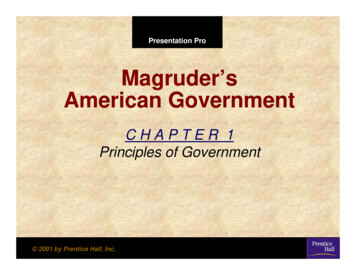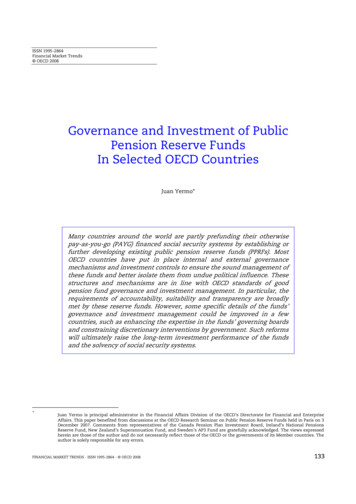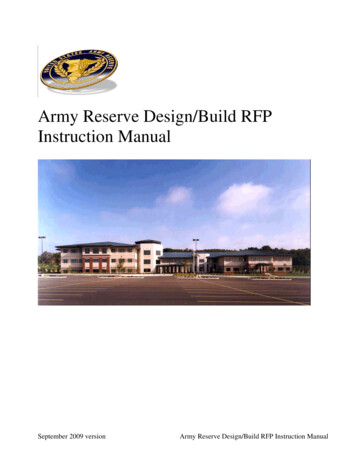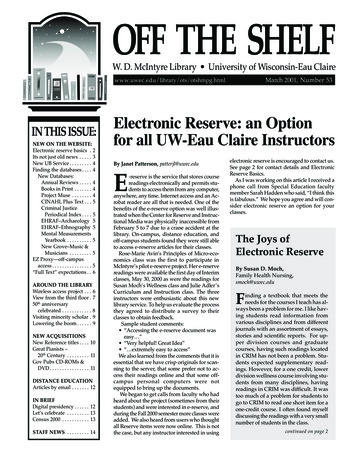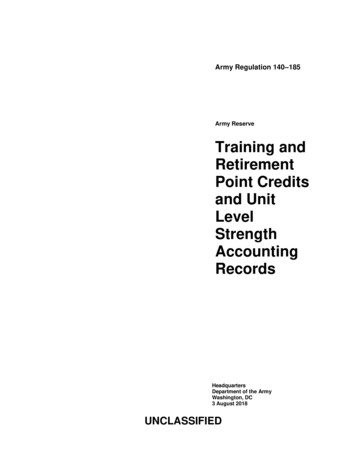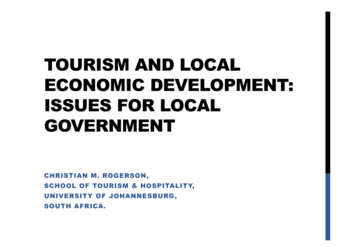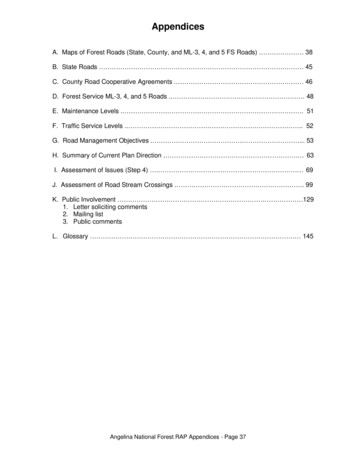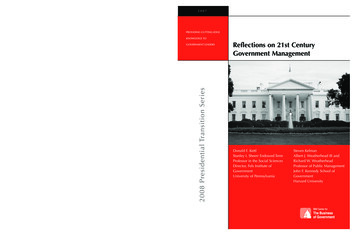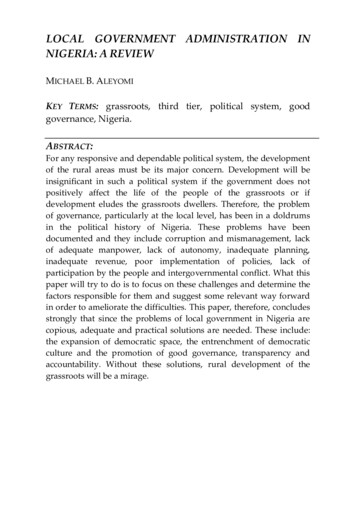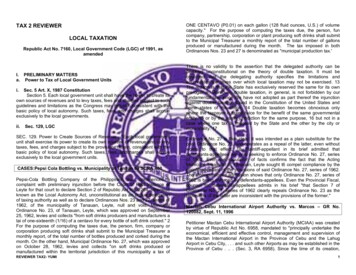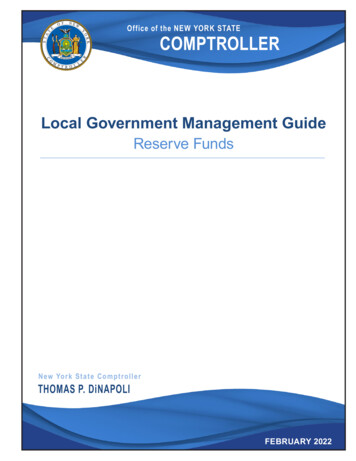
Transcription
Office of the NEW YORK STATECOMPTROLLERLocal Government Management GuideReserve FundsN ew Yo r k St a t e Co m p t ro ll e rTHOMAS P. DiNAPOLIFEBRUARY 2022
Table of ContentsIntended Use of Reserves2Board Direction and Oversight3Visibility of Reserve Fund Transactions4Investment of Reserve Funds4Reserve Fund Accounting Records and Reports5Reserves Authorized by the General Municipal Law (GML)6Capital Reserve Fund6Repair Reserve Fund11Contingency and Tax Stabilization Reserve Fund12Snow and Ice Removal and Road Repair Reserve14Reserve Fund for Payment of Bonded Indebtedness15Airport Amortization Fund16Airport Development Fund16Workers’ Compensation Reserve Fund17Electric Utility Depreciation Reserve Fund18Mandatory Reserve Fund19Unemployment Insurance Payment Reserve Fund20Insurance Reserve Fund21Solid Waste Management Facility Reserve23Employee Benefit Accrued Liability Reserve Fund24Retirement Contribution Reserve Fund25
Reserves Authorized By Other Statutes27Property Loss Reserve and Liability Reserve Fund27School District Capital and Tax Certiorari Reserve Funds28Tax Reduction Reserve Funds for School Districts30Career Education Instructional Equipment Reserve Fund–BOCES31General Reserve Fund–Suburban Towns32Reserve Fund for Improvement District–Suburban Towns33Reserve Fund for Judgments and Claims–Suburban Towns34Tax and Revenue Anticipation Fund for Counties35Appendix A: Reserves Authorized by GML Article 236Appendix B: Towns in Adirondack Park37Appendix C: “Specific” Sample Resolution38Appendix D: “Type” Sample Resolution39Notes40Contacts42
Reserve FundsSaving for future projects, acquisitions and other allowable purposes is an important planningconsideration for local governments and school districts. Reserve funds provide a mechanismfor legally saving money to finance all or part of future infrastructure, equipment and otherrequirements. Reserve funds can also provide a degree of financial stability by reducing relianceon indebtedness to finance capital projects and acquisitions. In uncertain economic times, reservefunds can also provide officials with a welcomed budgetary option that can help mitigate the need tocut services or to raise taxes. In good times, money not needed for current purposes can often beset aside in reserves for future use.In addition to reserve funds, maintaining a reasonable amount of unassigned fund balance withinoperating funds is another important financial consideration for local governments and schooldistricts. A reasonable level of unrestricted, unappropriated fund balance provides a cushion forunforeseen expenditures or revenue shortfalls and helps to ensure that adequate cash flow isavailable to meet the cost of operations.1 Combining a reasonable level of unassigned fund balancewith specific legally established reserve funds provides resources for both unanticipated eventsand other identified or planned needs. Although this guide is primarily focused on planning forspecific needs through legal reserve funds, our companion guides Financial Condition Analysisand Understanding the Budget Process contain additional information on maintaining and utilizingunrestricted fund balances.This guide describes the types of reserve funds that local governments and school districts canestablish and maintain. In general, reserve funds have specific intended purposes and requirementsas set forth in law. This guide contains a summary of the many different types of reserve fundsauthorized by New York State statutes. The descriptions included in this guide provide informationon: General provisions for each type of reserve fund Purposes for which each reserve fund may be used Special provisions, if applicable, that pertain to certain reserve funds, such as: Maximum total reserve balance permitted Maximum annual contribution in any fiscal year Referendum requirements for establishing or expending from reserve funds Permitted uses of any unobligated or excess reserve funds.Because of the complexity of some of the legal requirements relating to the establishment, funding,expenditure and dissolution of reserve funds, we encourage local officials to consult with theirmunicipal attorney and to exercise professional judgment in determining how best to includereserve funds in the overall financial management policies of their government or school district.Local Government ManagementGuide ReserveAgenciesFundsIndustrialDevelopment1
Intended Use of ReservesReserve funds, like other savings plans, are mechanisms for accumulating cash for future capitaloutlays and other allowable purposes. The practice of planning ahead and systematically saving forcapital acquisitions and other contingencies is considered prudent management. Saving for futurecapital needs can reduce or eliminate interest and other costs associated with debt issuances.Similarly, certain reserve funds can be utilized to help protect the budget against known risks (apotential lawsuit) or unknown risks (a major ice storm).Most reserve funds are established to provide resourcesfor an intended future use. An important concept toremember is that a reserve fund should be establishedwith a clear intent or plan in mind regarding the futurepurpose, use and, when appropriate, replenishment offunds from the reserve. Reserve funds should not bemerely a “parking lot” for excess cash or fund balance.Local governments and school districts should balancethe desirability of accumulating reserves for futureneeds with the obligation to make sure taxpayers arenot overburdened by these practices. There should be aclear purpose or intent for reserve funds that aligns withstatutory authorizations.Planning today and savingincrementally for expectedfuture events can help mitigatethe financial impact of major,nonrecurring or unforeseenexpenditures on your annualoperating budget.Each statute that authorizes a reserve fund sets forth a particular underlying purpose for the fund.For example, provisions of the General Municipal Law (the GML) and the Education Law allow localgovernments and school districts, respectively, to establish capital reserves for future equipmentpurchases and capital improvements. The GML also authorizes the establishment of an employeebenefit accrued liability reserve for the payment of the monetary value of accumulated, unusedleave time to employees upon separation from service.Planning today and saving incrementally for expected future events can help mitigate the financialimpact of major, nonrecurring or unforeseen expenditures on your annual operating budget.Establishing and funding allowable reserve funds for a clear purpose can help smooth out spikes inthe annual budget and in the real property tax levy.2Local Government Management Guide Reserve Funds
Board Direction and OversightReserve funds can be excellent financial planning tools when combined with a realistic analysis offuture financial needs and obligations. All too often, however, reserve funds are established andsubstantial cash is accumulated without due diligence in monitoring the reasonableness of reservefund balances. To help ensure that reserve funds are being properly established for an authorizedand needed purpose, and the balances in existing reserve funds are not accumulated excessivelyor unnecessarily, governing boards should answer the following questions: Has legal counsel provided guidance on the authority to establish new reserve funds? Has thefinancial need or purpose served by the reserve been identified? Does the reserve fit within orcomplement the long-range financial or capital plans of our locality? Has a written reserve fund plan or policy been developed? What events and obligationsare the board planning for? Is cash being accumulated for the purchase of a major piece ofequipment or to help finance other major capital outlays? Is cash being sequestered to helpmitigate the impact of other large, nonrecurring expenditures? Are there risks that need to beprotected against? Does the board’s policy address replenishing depleted reserve balances, asappropriate? Is the board provided with periodic financial reports on reserve fund activity? Are reservebalances at an appropriate level? Has the board reviewed all reserve funds currently established and determined if the balancesare necessary and reasonable? Is there a limit on the dollar amount to be accumulated? Isthe reserve serving the purpose for which it was established? Are the best interests of thetaxpayers being met?Any governing board that is planning to establish andfinance reserve funds on a regular basis should developa written policy that communicates to taxpayers why themoney is being set aside, the board’s financial objectivesfor the reserves, optimal funding levels, and conditionsunder which the assets will be utilized. Boards shouldalso periodically assess the reasonableness of theamounts accumulated in their reserves. When conditionswarrant (subject to legal requirements), the board shouldreduce reserve funds to reasonable levels or liquidateand discontinue a reserve fund that is no longer neededor whose purpose has been achieved.Reserve funds can be excellentfinancial planning tools whencombined with a realistic analysisof future financial needs andobligations.Local Government ManagementGuide ReserveAgenciesFundsIndustrialDevelopment3
Visibility of Reserve Fund TransactionsAll reserve fund transactions should be transparent to the public. Reserve funds are typically fundedfrom amounts raised through the annual budget process, transfers from unexpended balances ofexisting appropriations and surplus moneys. Ideally,amounts to be placed in reserve funds should beReserve funds are typicallyincluded in the annual budget. By making provisionsto raise resources for reserve funds explicit in thefunded from amounts raisedproposed budget, the board gives voters and residentsan opportunity to know the board’s plan for fundingthrough the annual budgetits reserves. When appropriations for transfers toprocess, transfers fromreserve funds are not anticipated in the annual budget,a governing board resolution is generally necessaryunexpended balances of existingto authorize the transfer of unexpended balances orappropriations and surplussurplus money into a reserve fund. The resolution shouldinclude specifics about the amount to be transferred andmoneys.the reserve fund to be credited. These resolutions helppromote visibility of the board’s actions to taxpayers.The expenditure of reserve fund money is generally guided by the specific statute authorizing thereserve fund. Due care should be taken to adhere to all statutory requirements, as well as to makeappropriate disclosure of such transactions in the budget, accounting records and financial reports.2Investment of Reserve FundsGenerally, reserve funds must be invested under provisions of the GML.3 Interest earned and capitalgains realized on investments accrue to, and become part of, each reserve fund. In short, interestand gains on reserve fund balances “follow the principal.” If reserve fund cash is commingled withother moneys for investment purposes, each reserve fund must receive its prorated share of anyinterest or capital gains earned on the total investment. Reserve fund moneys are not required to bekept in separate bank accounts, but the law generally requires that separate accounting records bekept for each reserve fund.4Local Government Management Guide Reserve Funds
Reserve Fund Accounting Records and ReportsThe accounting records for each reserve fund generallymust show:The Office of the State The date and amount of each sum paid into the fundComptroller will assist you with Interest earned by the fundany questions you have regarding Capital gains or losses resulting from the sale ofinvestments of the fundin this guide or any special The amount and date of each withdrawal from thefundthe information containedcircumstances with which youmay need assistance. The total assets of the fund, showing cash balanceand a schedule of investments.This information may be used for the detailed report of the operation and condition of the fund thatmust be submitted to the governing board each year.The Office of the State Comptroller will assist you with any questions you have regarding theinformation contained in this guide or any special circumstances with which you may needassistance. The addresses and telephone numbers for each of our regional offices, and our legalstaff, are located at the end of this publication. Please contact the regional office for your locality or,for legal issues, our legal staff with any questions you may have.Local Government ManagementGuide ReserveAgenciesFundsIndustrialDevelopment5
Reserves Authorized by the General Municipal Law(GML)Capital Reserve Fund (GML Sections 6-c, 6-g)PurposeTo finance all or part of the cost of construction, reconstruction or acquisition of: A “specific” or “type” capital improvement The acquisition of a “specific” or a “type” item(s) of equipment.The term “capital improvement” means: any physical improvement and any related preliminarystudies and surveys; lands or rights in land; any furnishings, equipment, machinery, or apparatusfor any physical improvement acquired at the time when such improvement is constructed,reconstructed or acquired.The term “equipment” includes any equipment, machinery or apparatus not included in the definitionof capital improvement and for which a period of probable usefulness has been provided by law.4Some examples of specific and type capital reserves are as follows:Capital ImprovementsSpecificType6EquipmentCity HallTown GarageCounty JailFirehouseSewage Disposal PlantOff-Street Parking LotPumper TruckSanitation ng AlterationsSnow Removal EquipmentStreet Cleaning EquipmentHighway EquipmentFire ApparatusLocal Government Management Guide Reserve Funds
Who May CreateCounties, cities, villages, towns, fire districts, and town or county sewer and water improvementdistricts may create both specific and type capital reserves.5One exception is that capital reserve funds may not be established for capital improvementsconstructed, reconstructed, or acquired or equipment acquired as follows: On behalf of an improvement district or other similar district (other than a sewer and/or waterdistrict) located within a municipality Where all or part of the costs are borne by assessments for benefit or ad valorem taxes upon realproperty within the area of benefit in a municipality (other than a sewer and/or water district).6How to Create and UseSpecific Capital ReservesA governing board’s authorization (resolution) establishing a specific improvement or equipmentcapital reserve must state the estimated maximum cost of the item(s) of equipment or improvement.A sample resolution for establishing a specific capital reserve is included in Appendix C.The action of a governing board establishing a specific capital reserve is subject to permissivereferendum if an authorization to issue indebtedness for the same improvement or equipment issubject to either a permissive or mandatory referendum, except for fire districts. For fire districts,action of the board of fire commissioners establishing any capital reserve fund may not take effectuntil approved by a vote of qualified electors of the fire district (i.e., a mandatory referendum),effective January 1, 2007.There are no referendum requirements for expenditures made from a specific capital reserve fund.However, expenditures from specific capital reserve funds can only be made upon authorization ofthe governing board.Type Capital ReservesThe governing board should authorize (by resolution) the establishment of a type improvementor equipment reserve but, there is no requirement to state an estimated maximum cost of theequipment or improvement in the resolution. A sample resolution for establishing a type capitalreserve is included in Appendix D.A referendum is not required when establishing a type capital reserve fund, except in fire districts.For fire districts, action (resolution) of the board of fire commissioners establishing any capitalreserve fund may not take effect until approved by vote of qualified electors of the fire district (i.e., amandatory referendum).Local Government ManagementGuide ReserveAgenciesFundsIndustrialDevelopment7
For certain municipalities, expenditures made from a type capital reserve are subject to permissivereferendum. If an authorization to issue indebtedness for the purchase of such improvement orequipment is subject to either permissive or mandatory referendum, then the expenditure of typecapital reserve funds for the same purpose is generally subject to permissive referendum.Permissive and Mandatory Referendum RequirementsThere are two types of referendums that apply to the establishment of or the expenditure of capitalreserve funds. In this guide, the terms permissive and mandatory referendums are defined asfollows: Generally, an action subject to permissive referendum requires the municipality to publish andpost a legal notice informing taxpayers of the board’s planned action (e.g., the establishmentof a specific capital reserve). The legal notice also informs eligible voters of their right to file apetition to require the matter to be subjected to voter approval. For a mandatory referendum, no petition is filed and in all cases eligible voters of themunicipality must approve the proposed action or question before the action can take place.Permissive and mandatory referendum requirements for capital reserves are associated with thereferendum requirements for bond issues. Referendum requirements vary depending on the type ofmunicipality involved.8Local Government Management Guide Reserve Funds
The following chart summarizes the referendum requirements for the establishment andexpenditure of specific and type capital reserve funds.Type ofLocalityReferendum Requirements for Capital ReservesReferendumRequirements forBond IssuesSpecific ReservesType ReservesBond resolutions must beapproved at a regular orspecial election of districtvoters.Establishment is subject toa mandatory referendum.Establishment is subject toa mandatory referendum.Expenditures can only bemade following the adoptionof a resolution by the boardof fire commissioners.These resolutions are notsubject to referendum.Expenditures can onlybe made following theadoption of a resolution,subject to permissivereferendum.Bond resolutions are subjectto permissive referendumunless the proposed maturityof the bonds is five years orless, or unless the bonds areissued to finance judgmentsand claims, sewers andcapital improvementsfinanced by benefitassessments, certain streetand highway improvements,and incinerators and refusedisposal facilities.Bond resolutions may also besubmitted to referendum bymotion of the board.With certain exceptions,generally a permissivereferendum is requiredupon establishment, unlessthe period of probableusefulness of the specificcapital improvement orequipment is less than fiveyears.*No referendumrequirements forestablishment.TownWith certain exceptions,generally same as villages.Same requirements asvillages.**Same requirements asvillages.Generally not required.Generally not required.CityReferendums are not requiredunless specified in the citycharter or required by locallaw.Generally not required.Generally not required.CountyBond resolutions are notsubject to any referendumrequirements, except for bondresolutions for appraisals forequalization purposes, whichare subject to permissivereferendum.***Fire DistrictsVillagesNo referendum requirementsfor expenditures.With certain exceptions,generally a permissivereferendum is requiredprior to expenditure, unlessthe period of probableusefulness of the typecapital improvement orequipment is less than fiveyears.* See Local Finance Law Section 36.00(a) (1), which provides that bond resolutions in villages are not subject toreferendum when bonds have a proposed maturity of not more than five years.** See Local Finance Law Section 35.00 (b) (1), which provides that bond resolutions in towns are not subject toreferendum when bonds have a proposed maturity of not more than five years.*** Certain bond resolutions in excess of 10,000,000 are subject to mandatory referendum in Westchester County(Local Finance Law Section 33.10).Local Government ManagementGuide ReserveAgenciesFundsIndustrialDevelopment9
Source of FundsCapital reserve funds may generally be funded with: Budgetary appropriations7 Revenues not required by law to be paid into any other fund or account (e.g., transfers fromunexpended balances of existing appropriations and surplus moneys).Highway fund moneys (in towns) may be used for the establishment of a capital reserve, so longas the moneys are expended for the purpose for which they were levied or received, and providedthe town highway superintendent and town board consent and the county highway superintendentapproves. Such moneys may be expended from the capital reserve only on order of the townhighway superintendent, upon audit, and with the consent of the town board.Special ProvisionsIf a town is located wholly or partly in the Adirondack Park (see Appendix B) and has State landssubject to taxation assessed (at more than 30 percent of total taxable assessed valuation of thetown), the State Comptroller must consent to the establishment of, and expenditures or transfersfrom, a capital reserve fund in the town, or in a fire district located wholly or partly within such atown.Use of Unexpended BalancesGenerally, unexpended balances in a capital reserve fund may be transferred to another capitalreserve having the same tax base.a) Capital Reserve Balances Remaining After Completion or Acquisition If there is an unexpended(residual) balance remaining in a specific or type capital reserve after the capital improvementor item of equipment has been completed or acquired, the governing board may appropriate allor any part of such remaining balance to another capital reserve fund without referendum. Anamount sufficient to satisfy all outstanding claims arising from the construction, reconstruction,or acquisition of the improvement or the acquisition of the equipment should remain designatedfor such claims until they are satisfied.Additionally, in a municipality, all or part of the unexpended balance of a capital reserveestablished for a specific improvement or item of equipment that has been completed oracquired (less amounts required to satisfy all outstanding claims related to such improvementor equipment) may be appropriated for: An object or purpose for which bonds may be issued The payment of interest on and principal of indebtedness (except indebtedness forassessable improvements and certain indebtedness excludable from constitutional debtlimits) (GML Section 6-c [9-a]).b) Capital Reserve Balances Never Utilized Where a specific capital reserve has been established,and the improvement or item of equipment has not been acquired or completed, any transfer issubject to permissive referendum if the authorization for the creation of the reserve was subjectto permissive referendum.8 While subject to a public hearing with 15 days’ notice, unexpendedbalances may also be transferred to a Retirement Contribution Reserve Fund.910Local Government Management Guide Reserve Funds
Repair Reserve Fund (GML Section 6-d)PurposeTo pay for certain repairs to capital improvements or equipment. The type of repairs must not recurannually or at shorter intervals.Who May CreateMunicipal corporations (towns, villages, cities, counties), district corporations (e.g., fire districts),school districts, and town or county improvement districts.How to Create and UseThere are no referendum requirements for the establishment of a repair reserve fund or forexpenditures from the fund.10 A resolution appropriating moneys from a repair reserve fund issubject to a public hearing and at least five days must elapse between the publication of the noticeof hearing and the date specified for the hearing. In an emergency, moneys in a repair reserve fundmay be expended without giving notice and without holding a public hearing. To make such anemergency expenditure, the governing board must pass a resolution approved by at least a twothirds vote. In addition, at least one-half of the expenditure must be repaid in the next fiscal yearand the balance repaid by the end of the fiscal year after that.Source of FundsBudgetary appropriations and revenues that are not required by law to be paid into any other fundor account (e.g., transfers from unexpended balances of existing appropriations, surplus moneys).Special ProvisionsIf a town is located wholly or partly in the Adirondack Park (see Appendix B) and has State landssubject to taxation assessed at more than 30 percent of the total taxable assessed valuation in atown, the State Comptroller’s Office must consent to the establishment of, and appropriations from,a repair reserve fund in the town or in any district corporation or improvement district situated whollyor partially in such a town.Use of Unexpended BalancesAll or any part of a repair reserve fund may generally be transferred to a capital reserve fund or,in school districts, to a reserve fund established pursuant to Section 3651 of the Education Law,or to a contingency and tax stabilization reserve fund. Subject to a public hearing with 15 days’notice, unexpended balances may also be transferred to a Retirement Contribution Reserve Fund,established pursuant to GML Section 6-r.Local Government ManagementGuide ReserveAgenciesFundsIndustrialDevelopment11
Contingency and Tax Stabilization Reserve Fund (GML Section 6-e)PurposeTo finance certain unanticipated revenue losses or unanticipated expenditures chargeable to the“eligible portion of the annual budget,” and to lessen or prevent projected increases in excess of2½ percent of the amount of the real property tax levy needed to finance the eligible portion of theannual budget.The law defines “unanticipated expenditure” as “an expenditure for a specific purpose for whichthere is no or insufficient appropriation or which will cause an appropriation to be insufficient thatis necessitated by a change in federal or state laws, rules or regulations, a court order, judgmentor decree, a public emergency, or an industry-wide price, rate or premium increase, which takeseffect or occurs after final adoption of the annual budget and which could not have been reasonablyanticipated prior to final adoption of the annual budget.”An “unanticipated revenue loss” means “estimated revenue which is rendered unreceivablebecause of a change in federal or state laws, rules or regulations, a court order, judgment ordecree, or other circumstance, which takes effect or occurs after final adoption of the annual budgetand which could not have been reasonably anticipated prior to final adoption of the annual budget.”The “eligible portion of the annual budget” means, in the case of a contingency and tax stabilizationreserve fund established for: (1) a county, city, village or fire district, the general fund portion of theannual budget; (2) a town, the town-wide general fund and highway fund portions of the annualbudget; and (3) the part of a town outside any villages, the general fund and highway fund portionsof the annual budget for such part of the town.Who May CreateCounties, cities, villages, fire districts and towns (for town-wide and part-town general funds andhighway funds).How to Create and UseCreated by resolution of the governing board subject to permissive referendum. Generally, may beused only upon recommendation of the chief executive officer and resolution adopted by at least atwo-thirds vote of the governing board.Source of FundsBudgetary appropriations; unrestricted, unappropriated fund balance; and such revenues notrequired by law to be paid into any other fund or account. No amount may be appropriated forpayment into a contingency and tax stabilization reserve fund that would cause the balance of thefund to exceed 10 percent of the eligible portion of the annual budget for the fiscal year for whichthe appropriation would be made.12Local Government Management Guide Reserve Funds
Special Limitation on Maximum Amount in FundWhen preparing a tentative budget, if the current balance of the contingency and tax stabilizationfund exceeds 10 percent of the eligible portion of the annual budget for the current fiscal year, anyexcess must be used to reduce the amount of real property taxes needed to finance the eligibleportion of the annual budget for the next fiscal year.There are three additional limitations on the use of moneys in the fund: The maximum that may be used to finance an unanticipated revenue loss shall equal eitherthe amount of revenue actually received for the base year11 or the amount of the estimatedrevenue for the current fiscal year, whichever is less, minus the amount of the revenue actuallyreceived for the current year. In addition, moneys in the fund may be used only to finance thatportion of an unanticipated revenue loss which, as a matter of law, cannot be financed frommoneys available in any other account or fund. The maximum that may be used to finance an unanticipated expenditure shall equal the sumof the amount of the unanticipated expenditure and the amount appropriated for that purposefor the current fiscal year minus either the amount appropriated for that purpose for thecurrent fiscal year or the actual expenditure for the same purpose in the base year, whicheveris greater. In addition, moneys in the fund may be used only to finance that portion of anunanticipated expenditure that, as a matter of law, cannot be financed from moneys available inany other account or fund. The maximum that may be used to lessen or prevent a p
Reserve Fund for Improvement District-Suburban Towns 33 Reserve Fund for Judgments and Claims-Suburban Towns 34 Tax and Revenue Anticipation Fund for Counties 35 Appendix A: Reserves Authorized by GML Article 2 36 Appendix B: Towns in Adirondack Park 37 Appendix C: "Specific" Sample Resolution 38 Appendix D: "Type" Sample Resolution 39

